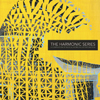 The anchoring of western music to equal temperament has on one hand lead to many musical developments but on the other hand, there is a whole world of musical textures and approaches to composition lost to instruments that are stuck playing in chromatic scales. On this excellent compilation, several artists explore intonation from a number of different approachesm utilizing a range of instruments. Ranging from almost ambient soundworks to difficult conceptual pieces, The Harmonic Series is an expansive anthology of unusual and beautiful music.
The anchoring of western music to equal temperament has on one hand lead to many musical developments but on the other hand, there is a whole world of musical textures and approaches to composition lost to instruments that are stuck playing in chromatic scales. On this excellent compilation, several artists explore intonation from a number of different approachesm utilizing a range of instruments. Ranging from almost ambient soundworks to difficult conceptual pieces, The Harmonic Series is an expansive anthology of unusual and beautiful music.
The idea of intonation alone is not a new one but it is a particularly apt type of tuning that fits with the technological and cultural movements of the 20th century. The mathematical side of just intonation and its reliance on whole number ratios sits comfortably beside ideas like quantum mechanics and the development of computer technology. Additionally, there is a feeling of otherness about pieces performed in intonation; the interaction between the notes sounding alien compared to the expected sounds that a modern ear conditioned to equal temperament. Michael Harrison’s “Tone Cloud II” transforms the familiar sound of a piano into a metallic shimmer, the interference from the different notes forming an uncertain backdrop to the relatively straightforward arrangement. Played on a piano tuned in a standard way, this would be a nice but inoffensive piece but Harrison allows the alternate tuning to give the music a hue that it would otherwise be lacking.
On “The Beauty of Sorrow” Pauline Oliveros shows a different side to intonation which accentuates its more musical side; the “wrong” feeling of the tuning negated by her sombre composition. Taking this “wrongness” and revelling in it, Charles Curtis’ “Stanzas Set Before a Blank Surface” is a difficult piece compared to the others included in The Harmonic Series. Harmonic intervals are combined with intervals of silence and all conventional musical forms are eschewed in preference of a total “sound for the sake of sound” approach. Curtis presents different blocks of sound, revelling in the overtones produced by his actions. It is the kind of piece where deep listening provides a profound and rewarding experience that will alienate your friends disinclined towards experimental music.
Although the notes accompanying Greg Davis’ “Star Primes (for James Tenney)” read more like readouts from an astrophysics experiment, the end result is a blissful drone piece which is beautiful but fails to exploit the use of intonation alone. The piece could be any electronic drone in any tuning as it does not seem (to these ears anyway) to capture the same rich oddness of the other pieces. Yet this is just nitpicking because at the end of the day because much like all of Davis’ work, the drone is immensely satisfying and whether my ears can detect it or not, the piece fully fits within the remit of the compilation.
Overall The Harmonic Series is one of those great compilations where everything comes together: the concept, the selection of artists and the final flow of the album. Additionally,The Harmonic Series also comes with comprehensive sleeve notes covering both the theory behind intonation in general and individual essays on each piece included on the compilation. Short of including some La Monte Young on it, I cannot think of how this album could be bettered.
samples:
- Michael Harrison, "Tone Cloud (For James Tenney)"
- Pauline Oliveros, "The Beauty of Sorrow"
- Charles Curtis, "Stanzas Set Before a Blank Surface"
Read More

